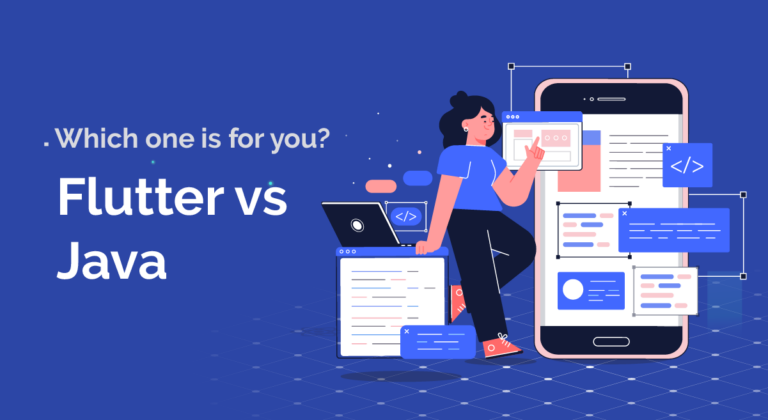We have to keep certain things in mind when talking about mobile app development. One of the things to note is the technology we’ll use to build our app. Flutter and Java are one of the main options considered when making a mobile application.
Flutter VS Java is a debate of usage, functionality, ease of development, and many other factors. While Flutter is cross-platform and can be used to build apps quickly, Java has been around for a lot longer which affirms its’ stability in the market.
We’ll take a detailed look at the differences between the two and we’ll also take a look at when to use which of the two. Keep reading to learn more!
History
Flutter is a framework to build cross-platform apps and it uses the programming language, Dart. It was created in 2017 by Google and it uses a single codebase that can be used to build apps for both the Android and the Apple platforms. It has quickly gained the favour of many developers.
Java, on the other hand, is a general-purpose language released in 1996 by Sun Microsystems. It can be used to develop any kind of software imaginable. Over the years, it has now become one of the most popular languages to develop enterprise-level applications and is used by many big corporations such as Uber, Apple, Instagram, Google, etc.
Java has been designed so it is written once, and can be run anywhere through the use of JVM.
In the case of Flutter Vs Java, Flutter is different. Flutter is a framework dedicated to building cross-platform mobile applications. One of its main features that outrun Java is its ability to create user interfaces quickly without having to write a lot of boilerplates and complex code.
Ease Of Learning
When we are discussing technologies to adapt, one of the first things we need to look at is their learning curve. This is one of the main factors that affect the development phases a lot.
In Flutter Vs Java, both of them have a learning curve.
Since Java is an older programming language, its syntax and rules are well documented but can be a bit hard on beginners. However, developers who have had experience with C-like languages will find it easier to adapt and learn.
While Flutter is a very new mobile app development framework, its simple UI and widget-based approach to creating apps makes it easy for developers to get into mobile app development. It also offers a lot of shortcuts for veteran android developers of Java and Kotlin. There are also several written and video tutorials available, as well as a large community to support Flutter developers. Therefore, Many developers find Flutter easier to learn as compared to Java.
Flutter vs Java: Comparison
Now we have basic understanding of flutter vs java, We will be comparing Flutter and Java based on following factors:
Performance
Flutter is known for its high-performance capabilities. It uses a GPU-accelerated rendering engine that allows for smooth animations and transitions. Flutter apps also have a smaller app size and faster load times compared to traditional native apps.
Java, on the other hand, is also known for its performance capabilities. It uses a Just-In-Time (JIT) compiler that optimises code during runtime. Java apps are known for their stability and can handle large amounts of data and traffic without compromising performance.
Development Time
Flutter’s biggest advantage is its ability to reduce development time. Since you can write code once and deploy it on both iOS and Android platforms, you can save a significant amount of development time and cost. This is why the Flutter framework is frequently used at vision spec for Custom Mobile Application Development.
Java, on the other hand, is a bit more time-consuming to develop. Since it is a more mature language, there are more development tools and frameworks available, which can make the development process more complex.
Community Support
Java has a large and active developer community. There are numerous resources available online, including forums, tutorials, and documentation. This makes it easy for developers to find solutions to problems they may encounter during the development process.
Flutter’s community is relatively smaller compared to Java. However, it is growing rapidly, and there are numerous resources available online. Google also provides extensive documentation and support for Flutter, which makes it easy for developers to get started.
Popularity
We have to look at the popularity of the two technologies when deciding on a mobile app development stack for several reasons. One of them is the community and third-party modules support. In development, we focus a lot on not reinventing the wheel, so the bigger the community is, it means that technology has seen its fair share of days and that one can easily trust it with a project without the worries of running into unexpected issues down the line.
When it comes to popularity in Flutter vs Java, Java is the winner as it has a far larger user base as compared to Flutter. At Stackshare, Java has over 89.2K followers while Flutter has over 13.5K followers.
We might also add that Flutter is majorly used for mobile app development and it is a framework. While java is a general-purpose programming language. Java is not only used for building mobile applications but embedded systems, web applications backends, mobile apps, GUI windows apps, etc. It also has been around for decades. While this is the case, we should also note that many developers are shifting to Flutter as it offers a fast way to build cross-platform apps quickly.
Documentation
When it comes to learning a new language or technology, it is essential to look into its available documentation and tutorials on the internet. Both Flutter and Java have good documentation to get developers started on their journey. Moreover, there are several courses as well as free tutorials available on major media streaming websites
Flutter official’s website offers a tutorial as well as detailed documentation.
Whereas Java’s site has a lot of documentation as well as links to Oracle’s libraries and resources along with a lot of other sources.
Conclusion
We went over a lot of details about comparing Java and Flutter. Java is a programming language that can be used to build pretty much anything out there. Flutter on the other hand is a mobile application framework that is used to create cross-platform apps through a single codebase. Both of these technologies have detailed documentation as well as a large community. Java has been around for decades while Flutter was recently introduced.
Flutter is simple to use and it is very easy to create user interfaces using it, while Java has been around for a longer time and no one can challenge its strength and robustness in the market.
At Vision Spec softwares, we use both Flutter and Java/kotlin/Swift for Cross Platform Mobile Applications and Native Applications respectively.
In simple terms, Flutter and Java have their advantages and disadvantages and we must keep an open mind when selecting any of the technologies for a project.

